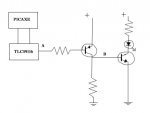Okay i need a sanity check of my circuit.
I'm building lights for the path at home as its an old brick path that roots have come and damaged and at night it can pose a trip hazard.
Anyway i'm using a TLC59116 LED controller, its a constant current PWM I2C LED controller which i'm using to control a common anode LED RGB light from The Big Clive. The LED controller pulls the pin in question low to turn the LED on. This means i can't simply use a normal transistor to turn the LEDs on.
I've attached a circuit diagram. When I turn the led on, point A should go low, which should pull point B high thus turning the LED on.
Will this work or do i not need the second transistor?
EDIT:
The datasheets are as follows:
TLC59116
LED light
I'm building lights for the path at home as its an old brick path that roots have come and damaged and at night it can pose a trip hazard.
Anyway i'm using a TLC59116 LED controller, its a constant current PWM I2C LED controller which i'm using to control a common anode LED RGB light from The Big Clive. The LED controller pulls the pin in question low to turn the LED on. This means i can't simply use a normal transistor to turn the LEDs on.
I've attached a circuit diagram. When I turn the led on, point A should go low, which should pull point B high thus turning the LED on.
Will this work or do i not need the second transistor?
EDIT:
The datasheets are as follows:
TLC59116
LED light
Attachments
-
49.3 KB Views: 66
Last edited:

